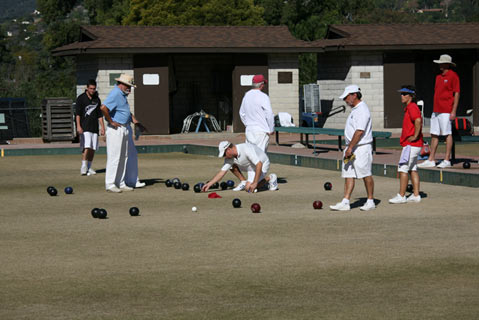Lawn Bowling for Gold

The afternoon sun is drying out the rink, it’s the last end of the match, and the jack is surrounded. What do you do? Heave and hope to cut your losses, or use your bias to bowl your way to victory?
If that made absolutely no sense, then you clearly haven’t entered the highly competitive world of lawn bowling.
Loren Dion, a 29-year-old Santa Barbara native and member of the US men’s lawn bowling team, is only the second American to win a singles medal in international lawn bowling competition. He did so by winning the bronze last month in Hong Kong. He is a fourth-generation lawn bowler, having entered his first tournament at age 8. Next month he will travel to Australia for another tournament. “I have friends in almost every country in the world that I can stay with because of this game,” Dion said.
“We’re trying to get the US to be better,” he added. “We’re not considered one of the best teams in the world.” The stiffest competition comes from Scotland, Australia, and New Zealand, according to Dion, whose company which makes glass cremation keepsakes sponsored the weekend-long tournament on January 16 and 17 in Santa Barbara.
Sam de Lisle, the SoCal selector for the US men’s team, has been lawn bowling for 20 years. “It’s the only game in the world where gender and age have nothing to do with the outcome,” he said, adding, “Some people come out for exercise, but I come out to win.” Competition ranges from singles to four-on-four.
So how does one play this centuries-old, Scot-inspired sport? The jack (or “the kitty,” as it is affectionately known), a white ball about the size of the baseball, is rolled to the opposite end of the rink. The rink is a 120-foot by 14-foot lawn of low-cut grass, which as the day goes on gets drier, making the balls run faster.
The bowlers then take turns trying to get as close as possible to the jack by rolling four bowls, which are specially designed balls about the size of a softball. Each set of bowls has its own bias, meaning that it will roll in a predictable, but unique, way.
In pairs, each team designates a lead and a skip. The lead bowls first. “I set ’em up and he knocks ’em down. That’s the theory,” explained Nick Savage, Dion’s lead and business partner. It is, of course, fair game to use your bowl to knock the competition’s out of the way. This is known as the “heave and hope” technique.
After everyone has bowled, whoever is closest to the jack gets a point for every bowl that is nearer than the opponent’s closest bowl. And yes, they have measuring tapes, and they’re not afraid to use them. Play continues until a pre-determined score is reached, lasting however many ends, or rounds, are necessary.
There two clubs in town are the Mackenzie Park Lawn Bowls Club (on upper State Street) and the Santa Barbara Lawn Bowls Club (adjacent to the Louise Lowry Davis Center at De La Vina and Victoria Streets). Dion and Savage play for the MacKenzie Park team. They grew up together in Santa Barbara, and now own Memory Glass, a glass-blowing company that puts a pinch of cremated ashes into decorative glass keepsakes. Dion said they sell mostly to funeral homes.
While Dion is well aware of the connection that might be made between his company and the mostly elderly demographic of lawn bowlers, he said they are not necessarily related. “It’s a close-to-death business, and most of the people who lawn bowl are close to death,” Dion said. He explained that he would sponsor lawn bowling events regardless of what his company did and that his motivation is to bring more attention to the sport, which is underrepresented in the United States.
Free lessons are available for anybody interested in trying their luck at lawn bowling. Contact the MacKenzie Park Lawn Bowls Club at (805) 563-5494 or Santa Barbara Lawn Bowls Club at (805) 966-1773.



